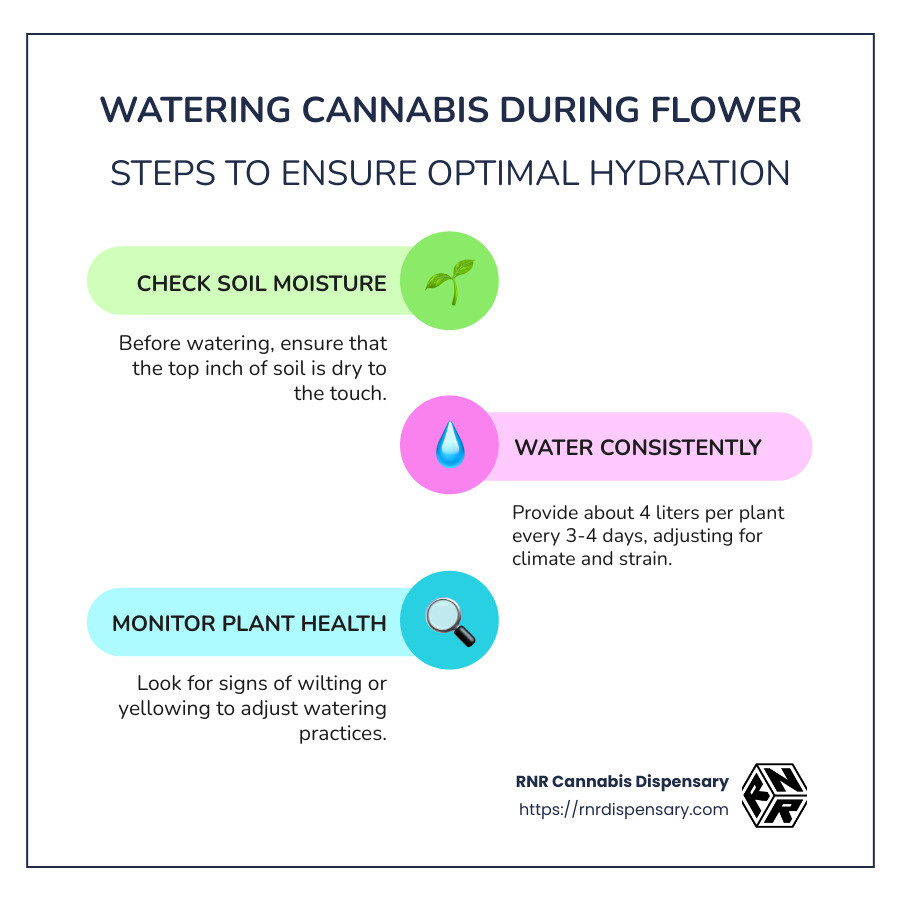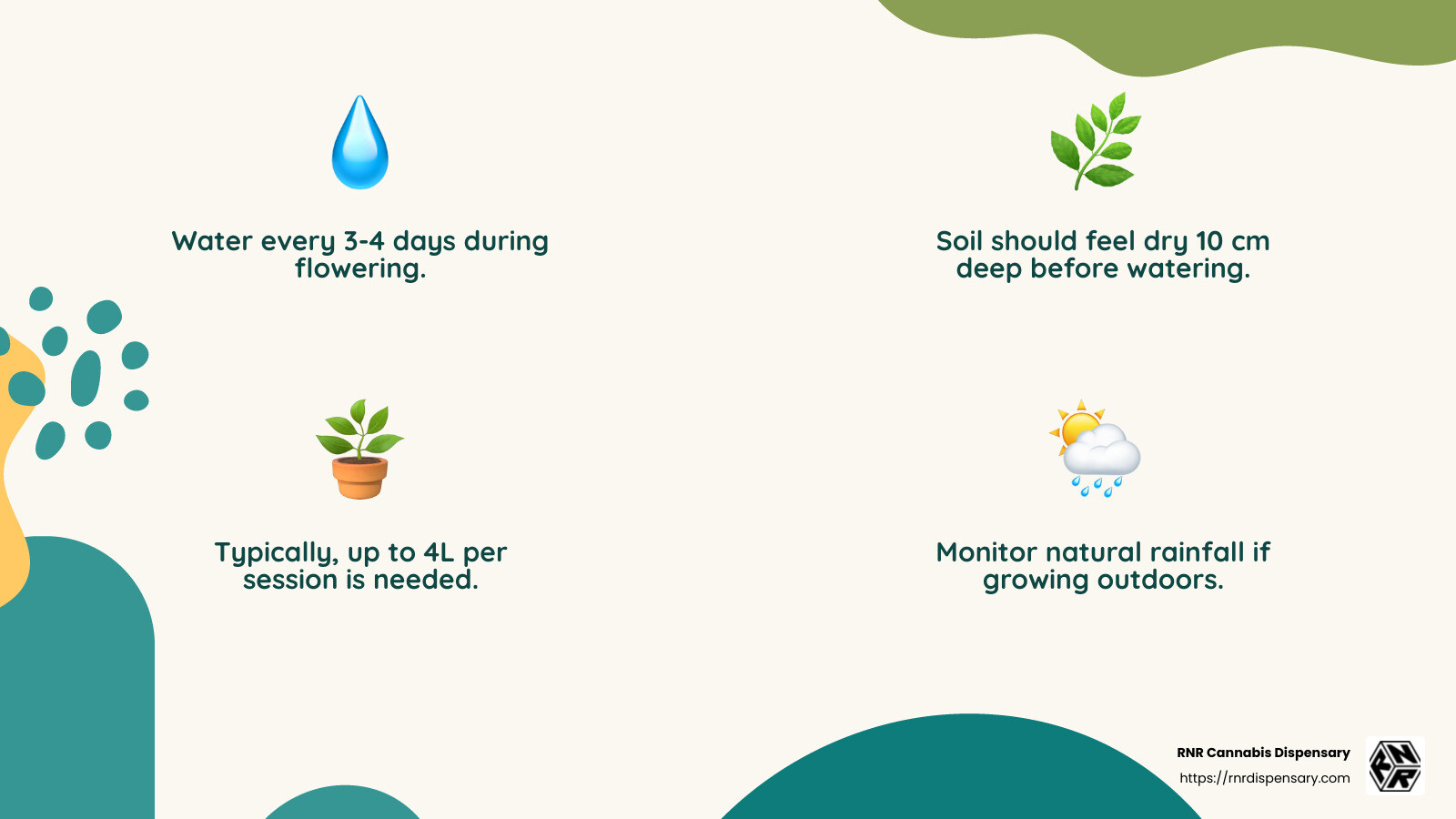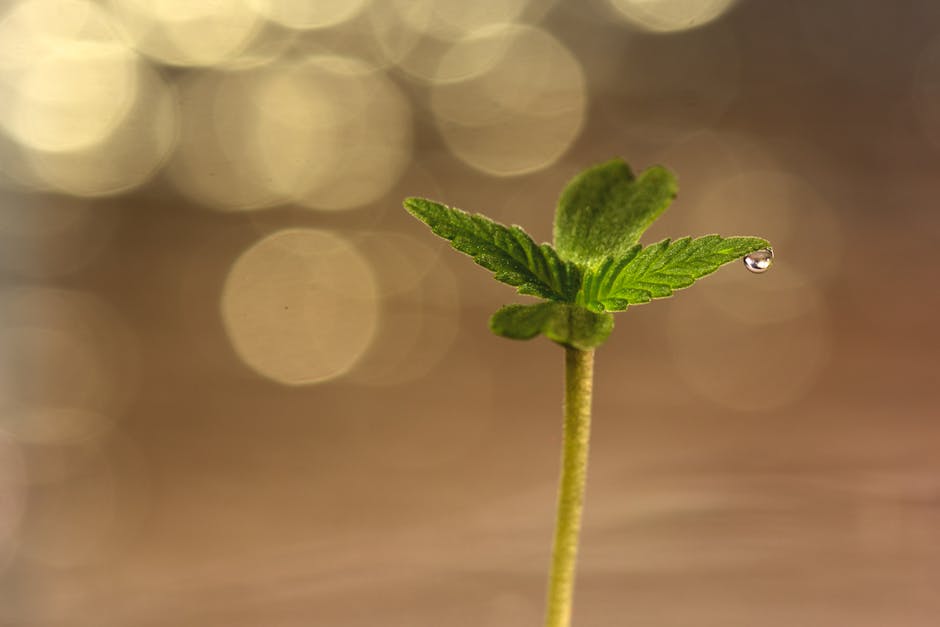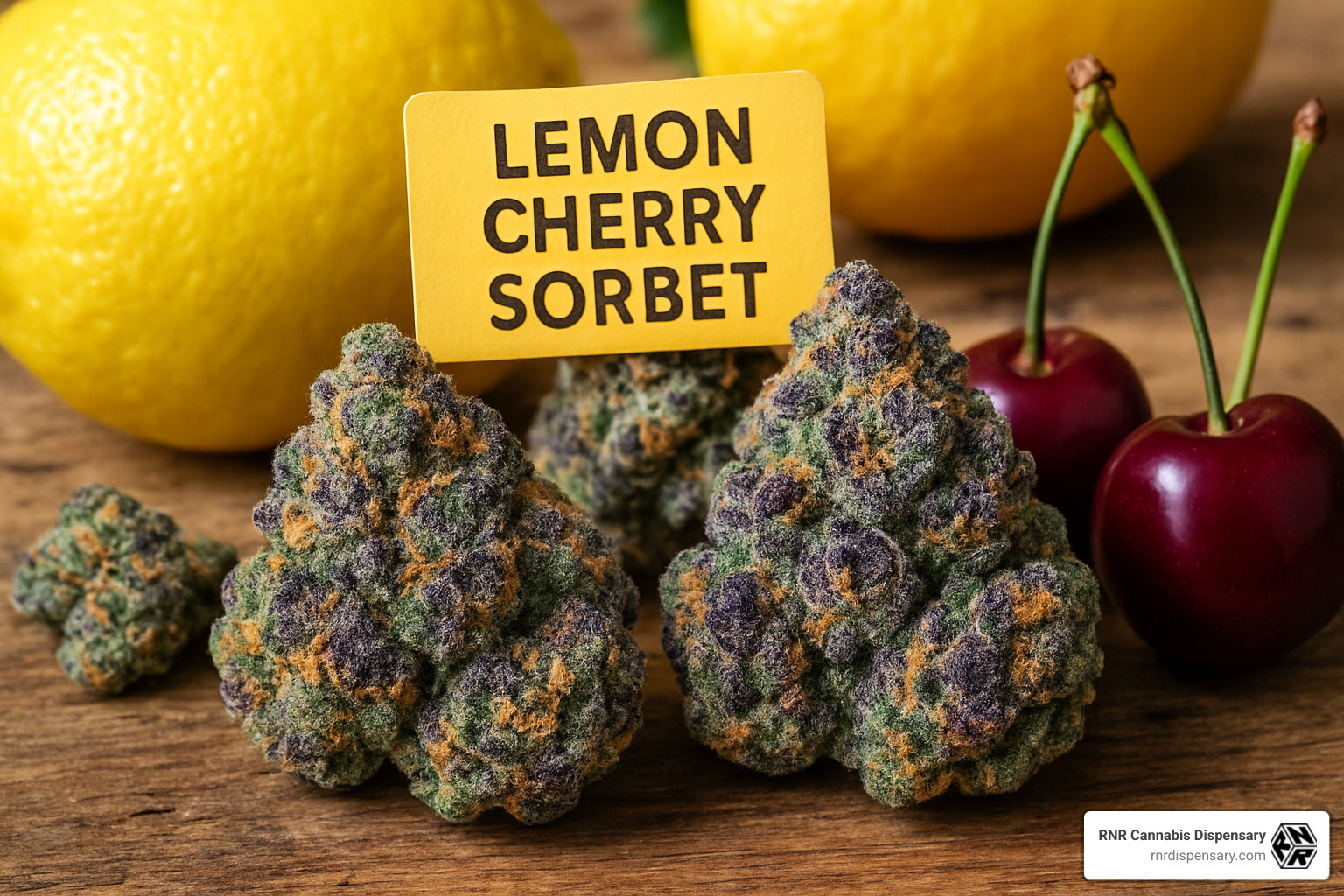When it comes to how much to water cannabis during flower, the key is understanding the unique needs of the plant at this pivotal stage. In general, watering every 3-4 days with about 4 liters per plant suits most conditions, though specific factors like strain and local climate can require adjustments.
In cannabis cultivation, the flowering stage marks the final but crucial phase before harvest, where watering practices can make or break the yield. Plants need adequate moisture to develop robust flowers, yet overwatering can be as damaging as neglecting to hydrate them. Consistent hydration is vital for healthy flower growth.
I’m Ronald Shen, author at RNR Cannabis Dispensary. With experience in advising on how much to water cannabis during flower, I bring insights from both community engagement and hands-on cultivation. Let’s dive deeper into perfecting watering practices for bountiful blooms.

How much to water cannabis during flower terminology:
– how to make a cannabis plant flower
– how much flower does one cannabis plant produce
– cannabis flower time lapse
Understanding the Flowering Stage
The flowering stage is a critical period in cannabis cultivation. It’s when the plant shifts its energy towards producing buds. During this stage, understanding root development, nutrient needs, and moisture levels is essential for a successful harvest.
Root Development
As cannabis transitions into flowering, its root system becomes well-established. Healthy roots are crucial for absorbing nutrients and water. At this stage, the roots are more developed, allowing the plant to take up more water efficiently.
However, ensuring proper drainage is vital to prevent root rot. Overwatering can lead to root damage and hinder the plant’s ability to absorb nutrients, ultimately affecting bud quality.
Nutrient Needs
During flowering, cannabis plants require a different nutrient profile compared to the vegetative stage. They need more phosphorus and potassium to support bud development, while nitrogen levels should be reduced. This shift in nutrient needs means that the plant’s watering routine should be adjusted accordingly to deliver the right balance of nutrients.
Moisture Levels
Maintaining optimal moisture levels is crucial during flowering. The soil should be kept moist but not waterlogged. Use the soil moisture check method by probing the soil to a depth of about 10 cm. If it’s dry, it’s time to water.
Consistent moisture helps in the healthy development of flowers. In regions with low humidity or infrequent rain, more frequent watering might be necessary. Conversely, in humid climates, less frequent watering can prevent mold growth, which thrives in high humidity conditions.

By understanding the unique requirements of the flowering stage, growers can tailor their watering practices to ensure robust and healthy cannabis flowers.
Next, we’ll explore best practices for watering cannabis, focusing on timing, soil type, and pH levels to maximize your yield.
How Much to Water Cannabis During Flower
Watering cannabis during the flowering stage requires a careful balance to ensure healthy bud development. Watering frequency, soil moisture checks, and the optimal water amount are key factors to consider during this critical phase.
Watering Frequency
During the flowering stage, cannabis plants typically need watering every 3 to 4 days. This frequency can vary depending on several factors, including climate conditions, plant size, and soil type. For instance, plants in drier environments may require more frequent watering compared to those in more humid areas.
Soil Moisture Check
A simple yet effective way to determine when to water is the soil moisture check. Insert your finger into the soil up to about 10 cm deep. If the soil feels dry at this depth, it’s time to water. This method helps prevent overwatering, which can lead to root rot and negatively impact plant health.
Optimal Water Amount
The amount of water needed during flowering can vary based on the plant’s size and the growing environment. On average, cannabis plants in this stage require up to 4 liters of water per watering session. However, always adjust based on the specific needs of your plants.

It’s essential to avoid waterlogging the soil. Proper drainage is crucial to prevent excess water from damaging the roots. If you’re growing cannabis outdoors, keep an eye on natural rainfall and adjust your watering schedule accordingly.
By mastering these watering techniques, you can support your cannabis plants in producing vibrant and healthy flowers. Up next, we’ll dive into the best practices for watering, including timing, soil type, and pH levels to optimize your cannabis cultivation efforts.
Best Practices for Watering
To ensure your cannabis plants thrive during the flowering stage, follow some best practices when it comes to watering. Let’s explore the key aspects: watering time, soil type, drainage, and pH levels.
Watering Time
Timing is crucial when watering your cannabis plants. The best time to water is early in the morning. This allows the plants to absorb moisture throughout the day and helps prevent mold and mildew, which can occur if the plants remain wet overnight. If mornings are not feasible, aim for late afternoon, but avoid watering in the evening.
Soil Type
The type of soil you use can greatly impact how well your cannabis plants absorb water. Loamy soil is often recommended for cannabis cultivation due to its excellent balance of drainage and nutrient retention. It allows roots to grow freely and access the moisture they need without becoming waterlogged.
Drainage
Proper drainage is essential to prevent water from pooling at the roots, which can lead to root rot and other issues. Ensure your pots have sufficient drainage holes, and consider using a layer of gravel or perlite at the bottom to improve water flow. Good drainage ensures that excess water can escape, keeping the soil from becoming saturated.
pH Levels
Maintaining the correct pH level in your water is crucial for nutrient uptake. Cannabis plants prefer a slightly acidic environment, with a pH range of 6 to 6.5. If your water’s pH is outside this range, you can adjust it using pH up or pH down solutions. Consistently monitoring and adjusting the pH will help your plants absorb nutrients more efficiently.
By adhering to these best practices, you can create an optimal environment for your cannabis plants during the flowering stage. Proper timing, soil selection, drainage, and pH management all contribute to healthier and more productive plants. Up next, we’ll discuss common mistakes in watering and how to avoid them to ensure your plants reach their full potential.
Common Mistakes and How to Avoid Them
When it comes to watering cannabis during the flowering stage, making mistakes is easy but avoidable. Let’s look at some common pitfalls and how you can steer clear of them.
Overwatering
Overwatering is a frequent issue that can lead to root rot and nutrient deficiencies. When cannabis roots are constantly soaked, they can’t get the oxygen they need. This can make your plants weak and stunt their growth.
How to Avoid Overwatering:
-
Check Soil Moisture: Before watering, stick your finger about an inch into the soil. If it’s dry, it’s time to water. If it’s still moist, hold off.
-
Use Proper Drainage: Make sure your pots have enough drainage holes. This helps excess water escape, preventing the roots from sitting in water.
Underwatering
While overwatering is common, underwatering can also harm your plants. Without enough water, the plants can’t transport nutrients effectively, leading to wilting and slow growth.
How to Avoid Underwatering:
-
Watch for Signs: If leaves are drooping or the soil looks parched, your plants likely need water.
-
Consistent Schedule: Stick to a regular watering schedule based on your plant’s needs and environmental conditions, usually every 2-4 days during flowering.
Mold Prevention
Mold is a serious concern during the flowering stage. High humidity and wet conditions can promote mold growth, which can ruin your crop.
How to Prevent Mold:
-
Water in the Morning: Watering early allows excess moisture to evaporate during the day, reducing the risk of mold.
-
Ensure Good Airflow: Use fans to keep air moving around your plants, which helps prevent moisture build-up.
By avoiding these common mistakes, you can ensure your cannabis plants thrive during the flowering stage. Proper watering techniques, combined with good environmental management, will help your plants grow healthy and strong.
Next, let’s dive into some frequently asked questions about watering cannabis to further improve your growing skills.
Frequently Asked Questions about Watering Cannabis
Can you over water in the flowering stage?
Absolutely, overwatering during the flowering stage can be quite detrimental. When cannabis plants receive too much water, their roots can become waterlogged, leading to root rot and other diseases. This happens because the roots are deprived of oxygen, which is crucial for their health and function. Over time, this can cause the plant to weaken and even die.
Signs of Overwatering:
- Yellowing leaves
- Wilting despite wet soil
- Moldy or musty smell around the plant base
To prevent this, always check the soil moisture before watering. Ensure your pots have adequate drainage to help excess water escape.
How often should I feed cannabis during flowering?
Feeding your cannabis plants during the flowering stage is essential for optimal growth and yield. However, nutrient balance is key. Most growers find success with a feeding schedule of once a week, but this can vary based on the strain and growing conditions.
Tips for Feeding:
- Follow a Schedule: Use a nutrient schedule provided by your nutrient supplier as a guide.
- Monitor Plant Response: If leaves start yellowing or showing signs of nutrient burn (brown tips), adjust the feeding amount.
- Flush Before Harvest: In the last two weeks of flowering, use plain water to flush out excess nutrients. This can improve the taste of the final product.
How do you know if your flowers need more water?
Knowing when your plants need water is crucial to avoid both overwatering and underwatering. Here are some wilting signs and indicators of soil dryness to watch for:
- Drooping Leaves: If the leaves look limp or droopy, your plant might be thirsty.
- Dry Soil: Stick your finger 1-2 inches into the soil. If it’s dry, it’s time to water.
- Lightweight Pot: Pick up your pot. If it feels lighter than usual, the soil might be dry.
By observing these signs, you can ensure your plants get the right amount of water, keeping them healthy and productive during the flowering stage.
Next, we’ll dig into the best practices for watering cannabis to help you refine your growing technique.
Conclusion
At RNR Cannabis Dispensary, we pride ourselves on offering a premium cannabis retail experience right in the heart of Bushwick, Brooklyn. Our unique approach blends luxury and local culture, providing an environment that is both refined and welcoming. We believe that cannabis is more than just a product—it’s a community experience.
Our dispensary is not just a place to purchase cannabis; it’s a hub for creativity and connection. We host events and engage with our community to foster a deeper understanding and appreciation of cannabis culture. Whether you’re a seasoned grower or new to cannabis, our knowledgeable staff is here to guide you every step of the way.
We offer a carefully curated selection of cannabis products, ensuring that each item meets our high standards of quality and sophistication. Our art-infused environment adds an extra layer of enjoyment, making each visit memorable.
Find more about our offerings and join our community by visiting our RNR Cannabis Dispensary. Whether you’re looking to improve your growing skills or simply enjoy the best that cannabis has to offer, we’re here to support you.
Frequently Asked Questions about Watering Cannabis
Can you over water in the flowering stage?
Yes, overwatering during the flowering stage can lead to root rot and other issues due to lack of oxygen. Look out for yellowing leaves and a musty smell as signs of overwatering.
How often should I feed cannabis during flowering?
Typically, feeding once a week works well, but adjust based on plant response. Watch for yellowing or nutrient burn and flush with plain water in the final weeks before harvest.
How do you know if your flowers need more water?
Check for drooping leaves, dry soil, and lightweight pots as indicators that your plants need watering. These signs help maintain the right moisture balance for healthy plant growth.



